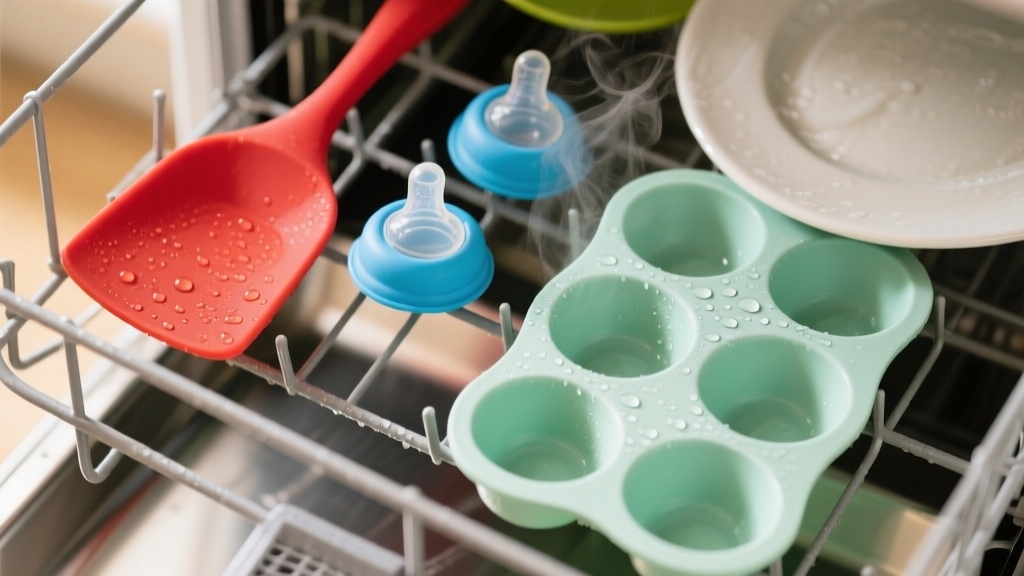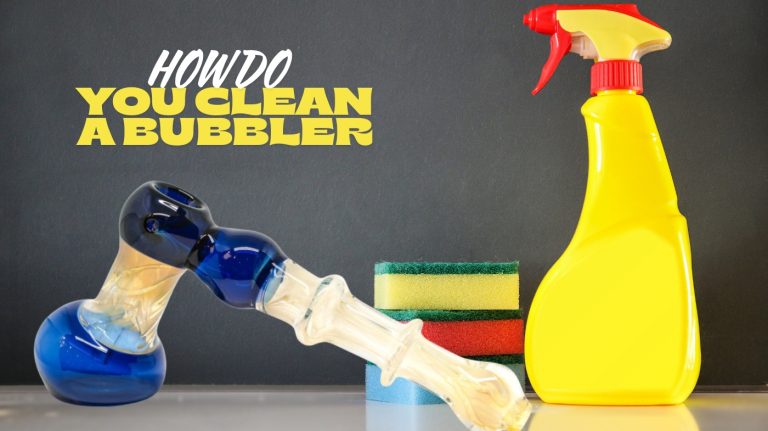Can Silicone Go in Dishwasher? Top Tips for Safe Cleaning
Yes, you can put most silicone kitchenware in the dishwasher safely. Just place items on the top rack, use mild detergent, and avoid high-heat or harsh cycles to preserve their shape and flexibility.
Proper spacing prevents damage and ensures thorough cleaning. Silicone’s heat resistance and durability make it dishwasher-friendly, but excessive heat or overcrowding can cause wear over time.
If you want to keep your silicone tools in top condition, there are smart care tips and loading tricks to know.
Key Takeaways
- Silicone kitchenware is generally dishwasher safe, maintaining flexibility and durability through multiple cleaning cycles.
- Place silicone items on the dishwasher’s top rack to avoid direct heat exposure and potential damage.
- Use mild, fragrance-free detergents and gentle cycles to preserve silicone quality and prevent degradation.
- Avoid overcrowding and secure silicone utensils properly to ensure thorough cleaning and prevent deformation.
- Follow manufacturer guidelines and maintenance tips to protect warranties and extend silicone lifespan in dishwashers.
Understanding Silicone Material in Kitchenware
Although you mightn’t always notice it, silicone plays an essential role in modern kitchenware thanks to its unique properties.
Its flexibility lets you bend spatulas and molds without them losing shape or breaking.
Silicone is non-toxic and FDA-approved, so it’s safe to use with food and won’t leach harmful chemicals.
Silicone’s non-toxic, FDA-approved nature ensures safe, chemical-free contact with your food every time.
Thanks to its low thermal conductivity, it prevents burns when handling hot items. Its non-porous nature also helps resist stains and makes cleaning easier.
You’ll also appreciate its water-repellent nature combined with breathability, which helps keep silicone kitchen tools dry and hygienic.
Plus, silicone comes in various colors and shapes, offering practical design options. To maintain its quality and appearance, it is important to clean silicone with mild detergents and avoid abrasive tools.
Heat Resistance and Durability of Silicone
Silicone’s flexibility and safety make it ideal for kitchen tools, but its heat resistance and durability truly set it apart in demanding environments like dishwashers. Its chemical stability also ensures it does not release harmful substances when exposed to heat or detergents commonly used in dishwashers, making it a safe material for repeated cleaning cycles.
Standard silicone withstands continuous heat up to 200°C (392°F) and brief peaks near 230°C (446°F) without degrading, covering typical dishwasher temperatures easily. Moreover, crosslinking modifications such as peroxide curing can enhance silicone’s thermal limits, improving its performance under heat stress.
Its siloxane backbone maintains elasticity and shape across wide temperature ranges, resisting oxidation and chemical breakdown. This inherent stability is comparable to the alkaline resistance seen in some effective oven cleaning sprays, which also operate under high-heat conditions without damage.
Unlike many elastomers, silicone remains stable where others fail, enduring rapid temperature changes without cracking. Plus, it stays flexible in cold conditions down to -60°C (-76°F), ensuring resilience through heating and cooling cycles.
While prolonged extreme heat can harden silicone, typical dishwasher exposure won’t cause significant wear, making it a durable choice for repeated washing.
Manufacturer Recommendations for Dishwasher Use
When you’re washing silicone items in your dishwasher, it’s really important to stick to the manufacturer’s guidelines.
This helps avoid any damage and keeps your warranty intact. Just think about it—nobody wants to accidentally ruin their favorite silicone bakeware! Silicone is generally dishwasher safe due to its heat resistance, making it convenient for cleaning.
However, it’s best to avoid using abrasive detergents or harsh cleaning agents that could degrade the silicone over time, ensuring long-lasting surface compatibility. Make sure to pay attention to their cleaning advice too. For example, they might recommend certain types of detergent or suggest steering clear of high-heat drying cycles.
If something’s not clear, don’t hesitate to check the product packaging or reach out to customer support. They’re there to help you out!
Follow Manufacturer Guidelines
When caring for silicone items in your dishwasher, following the manufacturer’s guidelines is essential to maintain their durability and performance.
Always check the product’s instruction manual to confirm if dishwasher use is recommended, as some manufacturers advise hand washing to preserve integrity. FDA-approved silicone rubber’s temperature resistance allows it to withstand dishwasher heat without losing flexibility or function.
Place silicone items on the top rack to avoid direct heat from the heating element. Use mild detergents with gentle or low-heat cycles to prevent degradation. Ensuring proper rinsing and drying after the dishwasher cycle helps avoid the buildup of residue that can cause irritation.
Proper spacing prevents contact with sharp utensils, reducing the risk of nicks. Pre-rinsing is often suggested to improve cleaning results.
Advantages of Washing Silicone in the Dishwasher
Washing silicone in the dishwasher? Oh, it’s a real time-saver! You can toss in multiple items all at once, and guess what? No extra scrubbing required. How great is that?
Not only does it effectively remove residues, but it also sanitizes surfaces. So, you can be sure your silicone is left spotless. Isn’t that a relief? Plus, it’s important to always adhere to the maximum temperature indicated by the manufacturer to avoid any chemical release during cleaning maximum temperature.
And here’s another bonus: this method helps maintain the flexibility and durability of your silicone items. That means they’ll last longer too. Who wouldn’t want that? Using proper cleaning methods and safe solvents can further protect delicate materials like silicone during washing.
Time-Saving Cleaning Method
Because silicone kitchenware tolerates high dishwasher temperatures without damage, you can save considerable time by using automated cleaning cycles instead of scrubbing by hand.
Its heat resistance and durability make it superior to most plastics, which can warp or degrade under similar conditions. This lets you multitask during meal prep and batch clean multiple items at once, cutting down overall kitchen cleanup time.
Silicone’s durability and heat resistance make it ideal for dishwasher use, ensuring your utensils last longer without warping or cracking. Similar to how solvents penetrate fibers to clean stains, the dishwasher’s water jets and heat effectively remove food residues from silicone surfaces.
Effective Residue Removal
Using your dishwasher for silicone items not only saves time but also delivers superior residue removal compared to hand washing.
Dishwashers use hotter water and powerful spray action that reach crevices where food particles often hide, effectively loosening stubborn residues.
This automated process guarantees consistent, thorough cleaning without relying on your scrubbing technique, reducing the risk of missed spots. Additionally, using appropriate cleaning tools helps maintain the material’s integrity.
Silicone’s heat resistance allows it to withstand high-temperature cycles without warping, so you get both cleanliness and durability.
Additionally, dishwashers sanitize by killing bacteria, which hand washing may not fully achieve. To maximize results, place silicone items on the top rack and use silicone-safe detergents to avoid residue buildup.
Silicone is made from food-grade silicone designed to withstand high heat and pressure, making it ideal for dishwasher use.
Maintains Silicone Flexibility
Although silicone can endure high dishwasher temperatures without damage, this resilience also means it retains its flexibility after many cleaning cycles.
Silicone withstands heat up to 482°F (250°C) without warping or becoming brittle, unlike plastic. This durability preserves its natural elasticity, so your spatulas and utensils stay bendable and effective.
The non-porous surface prevents odor absorption, keeping silicone utensils fresh and odor-free even after repeated washes. Using moderate dishwasher temperatures and recommended detergents prevents any material breakdown or hardening. Additionally, silicone’s resistance to heat and moisture helps inhibit mold growth, which can be a concern in kitchen tools.
Proper loading avoids compression, ensuring silicone maintains its shape and pliability. Additionally, regular cleaning helps prevent grease and oil buildup that can cause stickiness over time.
Overall, washing silicone in the dishwasher is a practical way to maintain its flexibility, texture, and lifespan without extra effort or special care.
Potential Risks of Dishwasher Cleaning for Silicone
When you clean silicone items in the dishwasher, several risks can affect their durability and safety. Silicone mats may come into contact with sharp objects, causing cuts that compromise their non-stick surface.
Crowded dishwashers increase this risk, making proper separation difficult. Additionally, silicone’s non-porous surface traps water, leading to mold if not dried thoroughly, which often requires extra hand drying. This ineffective drying can lead to mold or mildew growth if not addressed promptly.
Rolling or placing mats horizontally can block water flow, resulting in uneven cleaning. The dishwasher jets’ abrasive force may wear down silicone over time, reducing its lifespan. Using abrasive or unsuitable cleaning agents can further degrade silicone, similar to how harsh chemicals damage stone-safe surfaces.
Moreover, lower-quality silicone may leach synthetic chemicals when exposed to heat and fatty residues, posing health concerns. To protect your silicone, weigh these risks before using your dishwasher.
Selecting the Right Dishwasher Detergent for Silicone Items
Since silicone items require gentle care, choosing the right dishwasher detergent is essential to maintain their durability and safety.
You want to avoid harsh chemicals that can degrade silicone or leave residues. Instead, opt for mild, plant-based, or biodegradable detergents that protect the material and the environment.
Fragrance-free or unscented formulas prevent unwanted odors, keeping your silicone items fresh.
Also, consider detergent packs designed for sensitive materials to ensure consistent, residue-free cleaning.
Use sulfate-free and fragrance-free detergents to minimize soap residue and odor retention.
Avoid detergents containing essential oils or antibacterial agents that harm silicone.
Silicone’s resistance to extreme temperatures means it can withstand dishwasher cycles when properly cared for.
Choose pods or tablets for convenience and precise dosing. Select brands known for silicone-safe formulas like Puracy Natural or Seventh Generation.
Proper Loading Techniques for Silicone Utensils in Dishwashers
Hey there! When it comes to loading your silicone utensils in the dishwasher, it’s best to place them on the top rack. This helps keep them away from the direct heat that can sometimes warp or damage them.
Oh, and don’t forget to secure each item using a utensil holder! This little trick prevents them from moving around during the wash cycle, which is super important for keeping them in good shape.
Also, a quick tip: try to avoid letting your silicone utensils touch any sharp or heavy items in the dishwasher. This can help prevent any unwanted damage. Since silicone has high-temperature tolerance, keeping it away from intense heat sources during washing preserves its durability.
Placement Away From Heat
Although silicone utensils can tolerate dishwasher cleaning, you should always place them away from heat sources inside the dishwasher to prevent damage. High heat exposure from the heating element or heated dry cycle can warp or degrade silicone’s flexibility and surface over time.
To protect your utensils and extend their lifespan, follow these placement tips:
Position silicone utensils on the top rack, away from the heating element typically found on the bottom.
Avoid placing them near direct heat sources or heating coils to prevent localized melting.
Ensure they don’t rest against metal items, which can cause scratches and reduce their nonstick properties.
Leave enough space around utensils for proper water circulation, reducing heat concentration and promoting thorough cleaning.
Securing Items Firmly
To keep your silicone utensils safe and make certain a thorough clean, you must secure them firmly during loading.
Place silicone items in utensil holders or the top rack, using clips or adjustable racks if available, to prevent shifting during wash cycles.
Avoid overcrowding and nesting, which block water flow and reduce cleaning effectiveness. Position utensils facing downward to prevent water pooling and movement.
Group similar items together and consider using a third rack for smaller silicone tools like spatulas or whisks. Regularly inspect your dishwasher’s racks and holders to ensure they function properly.
Properly secured silicone utensils allow spray arms to rotate freely, enhancing cleaning efficiency, reducing noise, and preventing damage to both your utensils and dishwasher components. This is crucial because spray arms reach all surfaces, ensuring every item is cleaned evenly and thoroughly.
Avoiding Contact Damage
Since silicone utensils are flexible and prone to damage, you need to load them carefully to avoid contact with sharp or heavy items. Proper placement prevents cuts, punctures, and deformation during the wash cycle.
Keep silicone tools separated from knives, metal spatulas, and hard plastics to protect their non-stick surfaces. Also, avoid racks with exposed metal prongs that can tear or snag silicone surfaces.
Don’t stack silicone pieces tightly to prevent surface indentations. Finally, position edges and thin parts so they’re fully supported and won’t hang loosely. Place silicone utensils securely in utensil compartments to minimize movement.
Separate silicone tools from heavy pots and pans to avoid rubbing damage. Arrange silicone baking mats flat or loosely folded to maintain shape. Avoid overcrowding to reduce bending and folding during washing.
Signs of Wear and Damage From Dishwasher Exposure
When you frequently run silicone items through the dishwasher, you’ll notice several clear signs of wear and damage that affect their appearance and function.
Common indicators include surface dulling, cracking, color fading, and loss of flexibility. Structural issues such as warping or delamination can also occur.
Residue buildup and discoloration further impair usability and hygiene. Prolonged exposure to moisture and heat can contribute to material degradation.
| Type of Wear | Common Signs |
|---|---|
| Surface Wear | Dulling, tackiness, cracking |
| Structural Damage | Warping, deformation, delamination |
| Residue & Discoloration | White deposits, yellowing |
| Functional Decline | Loss of elasticity, sealing failure |
| Microbial Risk | Mold growth in cracks |
Watch for these signs to maintain your silicone’s longevity and safety.
Alternative Cleaning Methods for Silicone Kitchenware
Although dishwashers offer convenience, you’ll often get better results and preserve your silicone kitchenware longer by using gentler cleaning methods.
Silicone responds well to mild soap and warm water, which effectively remove residue without damaging the material.
Using a soft sponge or cloth prevents scratches, while rinsing immediately after use stops food from hardening.
For deeper cleaning, soaking in boiling water with dish soap or a vinegar solution helps eliminate grease and odors.
Use mild, unscented dish soap to avoid flavor transfer.
Clean with a soft sponge or brush to protect the surface.
Soak occasionally in a vinegar solution to remove persistent odors.
Air-dry or towel-dry thoroughly to prevent mold and water spots.
These methods keep your silicone kitchenware clean and in ideal condition. Regular cleaning also prevents spots and smells, ensuring your utensils stay hygienic and fresh.
Tips for Extending the Lifespan of Silicone Utensils
To extend the lifespan of your silicone utensils, you need to adopt careful cleaning, handling, and storage habits that protect their material integrity.
Clean them promptly with mild dish soap and warm water, avoiding abrasive scrubbers that cause micro-tears. Silicone’s non-stick properties also make cleaning easier and help maintain utensil quality.
Fully air-dry before storing to prevent mold and odors.
Only use dishwasher-safe silicone items and follow the manufacturer’s temperature guidelines, usually not exceeding 428°F (220°C).
Avoid direct contact with open flames or hot surfaces to prevent deformation.
Store utensils in cool, dry places away from sunlight to reduce UV damage.
Use silicone only for appropriate tasks like stirring or folding, not heavy chopping.
Regularly inspect for cracks or discoloration and replace damaged items to maintain safety and function.
These steps help keep your silicone utensils durable and effective.
Frequently Asked Questions
Can Silicone Lids Warp in a Dishwasher Over Time?
Silicone lids rarely warp in a dishwasher if they’re high-quality and food-grade.
You’ll find that dishwasher temperatures are well below silicone’s heat tolerance, so normal cycles won’t cause damage.
However, cheaper lids or repeated exposure to harsh conditions might affect shape over time.
To keep your lids in good shape, follow manufacturer guidelines, avoid stacking heavy items on them, and inspect regularly for any changes in flexibility or fit.
Does Dishwasher Use Affect Silicone’s Odor Retention?
Around 30% of users report that silicone items start smelling like past foods after repeated dishwasher use.
You should know that high heat and harsh detergents can cause microscopic changes in silicone, increasing odor retention.
To keep your silicone fresh, it’s best to hand wash with hot, soapy water and avoid prolonged dishwasher cycles.
Investing in high-quality silicone and promptly cleaning after use also helps minimize odors effectively.
Are Silicone Baking Mats Safe on the Dishwasher’s Top Rack?
Yes, you can safely place silicone baking mats on your dishwasher’s top rack.
Doing so protects them from intense heat near the bottom heating element, preserving their shape and durability.
Most manufacturers recommend this placement since silicone mats withstand dishwasher cycles without warping or cracking.
Using the top rack also simplifies cleaning, removing grease and residue efficiently while extending your mat’s lifespan and maintaining its non-stick surface.
Can Dishwasher Heat Cause Silicone to Leach Chemicals?
You might imagine dishwasher heat forcing silicone to release harmful chemicals, but that’s mostly a myth.
Under typical dishwasher temperatures (below 160°F), high-quality, food-grade silicone doesn’t leach chemicals.
However, repeated exposure to heat and detergents can slightly degrade low-quality silicone, potentially increasing minor leaching.
To stay safe, always use FDA-approved silicone, skip heated drying cycles, and replace any silicone showing damage or odors to minimize risks effectively.
How Does Water Hardness Impact Cleaning Silicone in Dishwashers?
Water hardness affects cleaning silicone in dishwashers by causing mineral buildup, which leaves spots and cloudy residue on silicone items.
You’ll notice reduced cleaning efficiency because limescale clogs spray arms and hampers detergent action.
To keep your silicone spotless, use water softeners or detergents designed for hard water, add rinse aids, and maintain your dishwasher regularly by descaling and cleaning filters.
This way, you’ll preserve your silicone’s appearance and hygiene.
Extend Your Silicone’s Life with Proper Cleaning
You can safely put most silicone kitchenware in the dishwasher, as silicone withstands temperatures up to 450°F.
In fact, over 80% of silicone utensils are dishwasher-approved by manufacturers. Just make sure to load them securely to avoid damage.
If you notice cracks or discoloration, consider hand washing instead. Following these simple steps helps you keep your silicone tools clean and durable without extra effort, saving you time and extending their lifespan.







